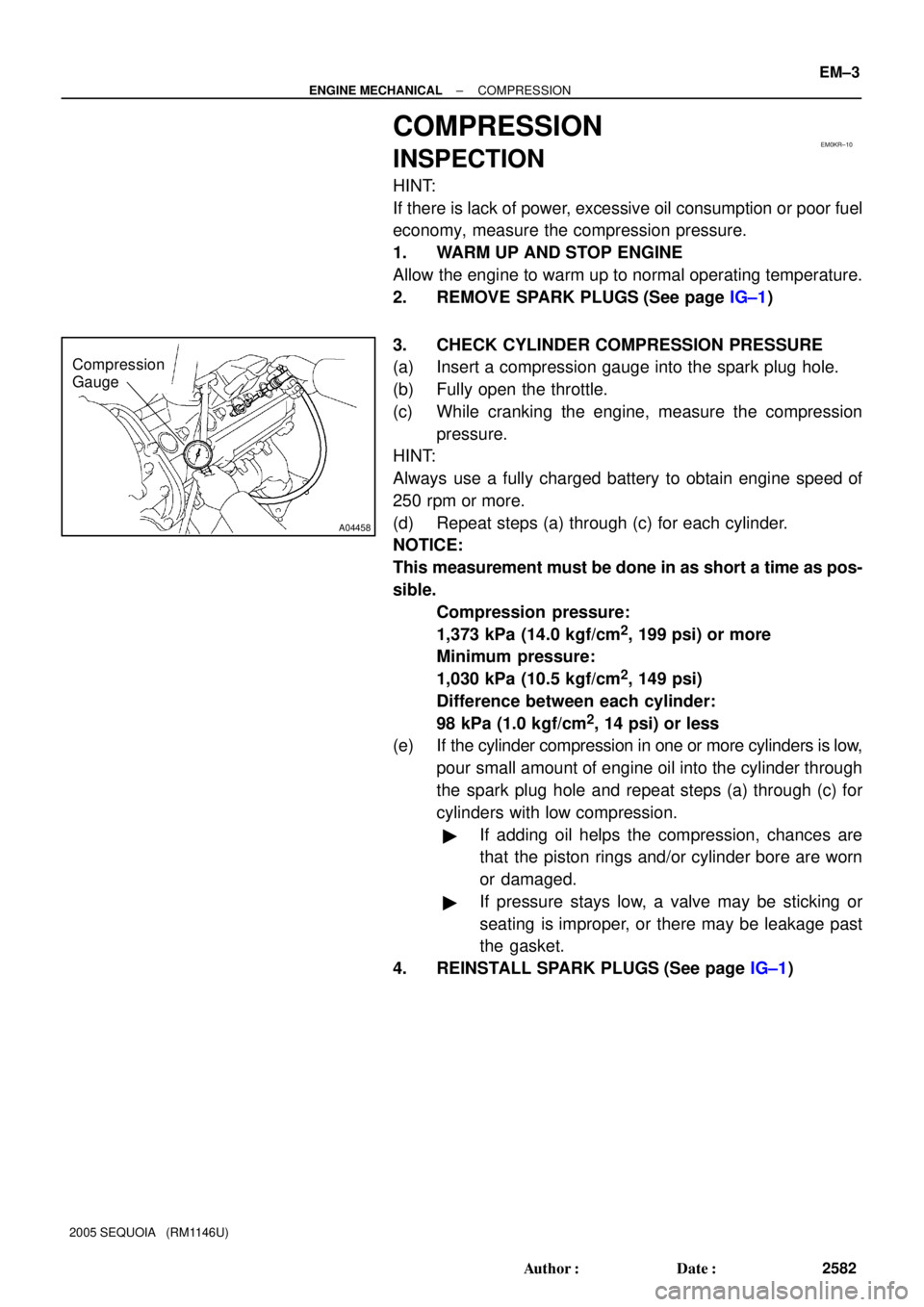Page 1859 of 4323
I28569
Combination Meter:
C5±27
I28581
Oil Pressure Sender Gauge
Wire Harness:
O2
± DIAGNOSTICSCOMBINATION METER SYSTEM
DI±1657
1851 Author�: Date�:
2005 SEQUOIA (RM1146U)
4 Check harness and connector (Oil pressure sender gauge ± combination meter).
PREPARATION:
Disconnect the C5 connector of the combination meter.
CHECK:
Measure the resistance according to the value(s) in the table
below.
OK:
Tester ConnectionSpecified Condition
C5±27 ± O2±1Below 1 W
C5±27 ± Body ground10 kW or higher
NG Repair or replace harness or connector.
OK
Replace combination meter
(See page IN±35).
Page 2499 of 4323

AC2810
DIDKM±01
AC2811
N11084
Wrong Okay
HI LO HILO
± DIAGNOSTICSAIR CONDITIONING SYSTEM
DI±2297
2491 Author�: Date�:
2005 SEQUOIA (RM1146U)
AIR CONDITIONING SYSTEM
PRECAUTION
1. DO NOT HANDLE REFRIGERANT IN AN ENCLOSED
AREA OR NEAR AN OPEN FLAME
2. ALWAYS WEAR EYE PROTECTION
3. BE CAREFUL NOT TO GET LIQUID REFRIGERANT IN
YOUR EYES OR ON YOUR SKIN
If liquid refrigerant gets in your eyes or on your skin:
(a) wash the area with lots of cool water.
CAUTION:
Do not rub your eyes or skin.
(b) apply clean petroleum jelly to the skin.
(c) go immediately to a hospital or see a physician for profes-
sional treatment.
4. NEVER HEAT CONTAINER OR EXPOSE IT TO NAKED
FLAME
5. BE CAREFUL NOT TO DROP CONTAINER OR APPLY
PHYSICAL SHOCKS TO IT
6. DO NOT OPERATE COMPRESSOR WITHOUT
ENOUGH REFRIGERANT IN REFRIGERATION SYS-
TEM
If there is not enough refrigerant in the refrigerant system, oil lu-
brication will be insufficient and compressor burnout may occur.
Necessary care should be taken to avoid this.
7. DO NOT OPEN HIGH PRESSURE MANIFOLD VALVE
WHILE COMPRESSOR IS OPERATE
Open and close only the low pressure valve. If the high pressure
valves are opened, refrigerant flows in the reverse direction
causing the charging cylinder to rupture.
8. BE CAREFUL NOT TO OVERCHARGE SYSTEM WITH
REFRIGERANT
If refrigerant is overcharged, it causes problems such as insuffi-
cient cooling, poor fuel economy, engine overheating etc.
Page 2590 of 4323

EM0KR±10
A04458
Compression
Gauge
± ENGINE MECHANICALCOMPRESSION
EM±3
2582 Author�: Date�:
2005 SEQUOIA (RM1146U)
COMPRESSION
INSPECTION
HINT:
If there is lack of power, excessive oil consumption or poor fuel
economy, measure the compression pressure.
1. WARM UP AND STOP ENGINE
Allow the engine to warm up to normal operating temperature.
2. REMOVE SPARK PLUGS (See page IG±1)
3. CHECK CYLINDER COMPRESSION PRESSURE
(a) Insert a compression gauge into the spark plug hole.
(b) Fully open the throttle.
(c) While cranking the engine, measure the compression
pressure.
HINT:
Always use a fully charged battery to obtain engine speed of
250 rpm or more.
(d) Repeat steps (a) through (c) for each cylinder.
NOTICE:
This measurement must be done in as short a time as pos-
sible.
Compression pressure:
1,373 kPa (14.0 kgf/cm
2, 199 psi) or more
Minimum pressure:
1,030 kPa (10.5 kgf/cm
2, 149 psi)
Difference between each cylinder:
98 kPa (1.0 kgf/cm
2, 14 psi) or less
(e) If the cylinder compression in one or more cylinders is low,
pour small amount of engine oil into the cylinder through
the spark plug hole and repeat steps (a) through (c) for
cylinders with low compression.
�If adding oil helps the compression, chances are
that the piston rings and/or cylinder bore are worn
or damaged.
�If pressure stays low, a valve may be sticking or
seating is improper, or there may be leakage past
the gasket.
4. REINSTALL SPARK PLUGS (See page IG±1)
Page 2633 of 4323

EM1X1±01
A03194
A03193
EM6323
EM6324
P21861
EM±46
± ENGINE MECHANICALCYLINDER HEAD
2625 Author�: Date�:
2005 SEQUOIA (RM1146U)
INSPECTION
1. CLEAN TOP SURFACES OF PISTONS AND CYL-
INDER BLOCK
(a) Turn the crankshaft, and bring each piston to top dead
center (TDC). Using a gasket scraper, remove all the car-
bon from the piston top surface.
(b) Using a surface contacting gasket scraper, remove all the
gasket materials from the cylinder block.
(c) Using compressed air, blow carbon and oil from the bolt
holes.
CAUTION:
Protect your eyes when using high pressure compressed
air.
2. REMOVE GASKET MATERIAL
Using a gasket scraper, remove all the gasket material from the
cylinder block contact surface.
NOTICE:
Be careful not to scratch the surface contacting the cylin-
der block.
3. CLEAN COMBUSTION CHAMBERS
Using a wire brush, remove all the carbon from the combustion
chambers.
NOTICE:
Be careful not to scratch the surface contacting the cylin-
der block.
4. CLEAN VALVE GUIDE BUSHINGS
Using a valve guide bushing brush and solvent, clean all the
guide bushings.
Page 2825 of 4323

CO0IO±07
± COOLINGCOOLANT
CO±1
2817 Author�: Date�:
2005 SEQUOIA (RM1146U)
COOLANT
INSPECTION
HINT:
Check the coolant level when the engine is cold.
1. CHECK ENGINE COOLANT LEVEL AT RADIATOR RESERVOIR
The engine coolant level should be between the ºLOWº and ºFULLº lines at normal temperature
(20°C(68°F)).
If low, check for leaks and add ºToyota Super Long Life Coolantº or similar high quality ethylene glycol based
non±silicate, non±amine, non±nitrite, and non±borate coolant with long±life hybrid organic acid technology
up to the ºFULLº line.
2. CHECK ENGINE COOLANT QUALITY
(a) Remove the radiator cap.
CAUTION:
To avoid the danger of being burned, do not remove the radiator cap while the engine and radiator
are still hot, as fluid and steam can be blown out under pressure.
(b) There should not be any excessive deposits of rust or scale around the radiator cap or radiator filler
hole, and the coolant should be free from oil.
If excessively dirty, clean the coolant passages and replace the coolant.
(c) Reinstall the radiator cap.
Page 2843 of 4323

B16233
Recommended Viscosity (SAE):
TEMPERATURE RANGE ANTICIPATED BEFORE NEXT OIL CHANGE5W±30°C °F
±20
±290
±1820
±740
460
1680
27100
38
LU0GV±05
B07230
Oil Pressure Gauge
Oil Pressure Switch
P08343
Adhesive
± LUBRICATIONOIL AND FILTER
LU±1
2835 Author�: Date�:
2005 SEQUOIA (RM1146U)
OIL AND FILTER
INSPECTION
1. CHECK ENGINE OIL QUALITY
Check the oil for deterioration, entry of water, discoloring or thin-
ning.
If the quality is visibly poor, replace the oil.
Oil grade:
API grade SL Energy±Conserving or ILSAC multi-
grade engine oil.
2. CHECK ENGINE OIL LEVEL
The oil level should be between the ºLº and ºFº marks on the dip-
stick.
If low, check for leakage and add oil up to the ºFº mark.
NOTICE:
Do not fill with engine oil above the ºFº mark.
3. REMOVE ENGINE UNDER COVER
4. REMOVE OIL PRESSURE SWITCH
5. INSTALL OIL PRESSURE GAUGE
6. WARM UP ENGINE
Allow the engine to warm up to normal operating temperature.
7. CHECK OIL PRESSURE
Oil pressure:
At idle29 kPa (0.3 kgf/cm2, 4.2 psi) or more
At 3,000 rpm294 ± 588 kPa (3.0 ± 6.0 kgf/cm2, 43 ± 85 psi)
8. REMOVE OIL PRESSURE GAUGE
9. REINSTALL OIL PRESSURE SWITCH
(a) Apply adhesive to 2 or 3 threads of the oil pressure switch.
Adhesive:
Part No. 08833±00080, THREE BOND 1344, LOCTITE
242 or equivalent
(b) Reinstall the oil pressure switch.
10. START ENGINE, AND CHECK FOR ENGINE OIL
LEAKS
11. REINSTALL ENGINE UNDER COVER
Page 2872 of 4323
IG0152
IG0148
P03792
± IGNITIONIGNITION SYSTEM
IG±3
2864 Author�: Date�:
2005 SEQUOIA (RM1146U)
(c) Clean the spark plugs.
If the electrode has traces of wet carbon, allow it to dry and then
clean with a spark plug cleaner.
Air pressure: Below 588 kPa (6 kgf/cm
2, 85 psi)
Duration: 20 seconds or less
HINT:
If there are traces of oil, remove it with gasoline before using the
spark plug cleaner.
(d) Check the spark plug for thread damage and insulator
damage.
If abnormal, replace the spark plug.
Recommended spark plug:
DENSO madeSK20R11
NGK madeIFR6A11
(e) Adjust the spark plug electrode gap.
Electrode gap: 1.0 to 1.1 mm (0.039 to 0.043 in.)
(f) Using a 16 mm plug wrench, install the spark plugs.
Torque: 17.5 N´m (180 kgf´cm, 13 ft´lbf)
(g) Reinstall the ignition coils (with igniter).
(see page IG±6)
Page 3021 of 4323

F19826
Rim
Sensor
Cap
Nut
WasherGrommet
F19827
Area for the sensorRim
Rim rotating
direction
Rim rotating
directionRim
Area for the sensor
Mount tool of the mounting machine
Mount tool of the mounting machine
± SUSPENSION AND AXLETIRE PRESSURE MONITOR VALVE
SA±17
3013 Author�: Date�:
2005 SEQUOIA (RM1146U)
�If installed in the reverse direction, the tire pressure
monitor valve may be damaged or fail to transmit sig-
nals when running at high speed.
�If installing a new tire pressure monitor valve, write
down the ID number before installation.
�It is necessary to registor an ID in the ECU after instal-
lation (See page DI±805).
(b) Install the washer on the tire pressure monitor valve from
the rim side and tighten with a nut.
Torque: 4.0 NVm (41 kgfVcm, 35 in.Vlbf)
NOTICE:
�Check that there is no foreign matter on the washer
and nut.
�If the tire pressure monitor valve is removed when the
tire is removed for replacement, check that there is no
damage or cuts, and no foreign matter such as mud,
dirt or sand attached to the grommet. Replace the
grommet with a new one if any of the defects men-
tioned above are found.
�Check that there is no oil, water or lubricant around
the rim hole, tire pressure monitor valve, washer and
nut. Failing to do so may result in improper installa-
tion.
(c) After the tire is inflated, the valve nut may be loose. Re-
tighten the nut to the specified torque and then check for
air leaks with soapy water.
Torque: 4.0 NVm (41 kgfVcm, 35 in.Vlbf)
(d) Set the wheel disc to the mounting machine and install the
lower tire bead. Position the main body of the sensor as
in the shaded area shown in the illustration.
NOTICE:
If the sensor is positioned outside this area, it generates in-
terference with the tire bead, causing possible damage to
the sensor.
(e) Install the upper bead.
NOTICE:
Make sure that the tire bead and tool do not interfere with
the main body of the sensor and that the sensor is not
clamped by the bead.
5. INSTALL FRONT WHEEL
Torque: 103 NVm (1,050 kgfVcm, 76 ftVlbf)
6. INSTALL REAR WHEEL
Torque: 103 NVm (1,050 kgfVcm, 76 ftVlbf)
7. INSPECT TIRE (See page SA±3)
8. REGISTRATION OF TRANSMITTED ID
(See page DI±805)